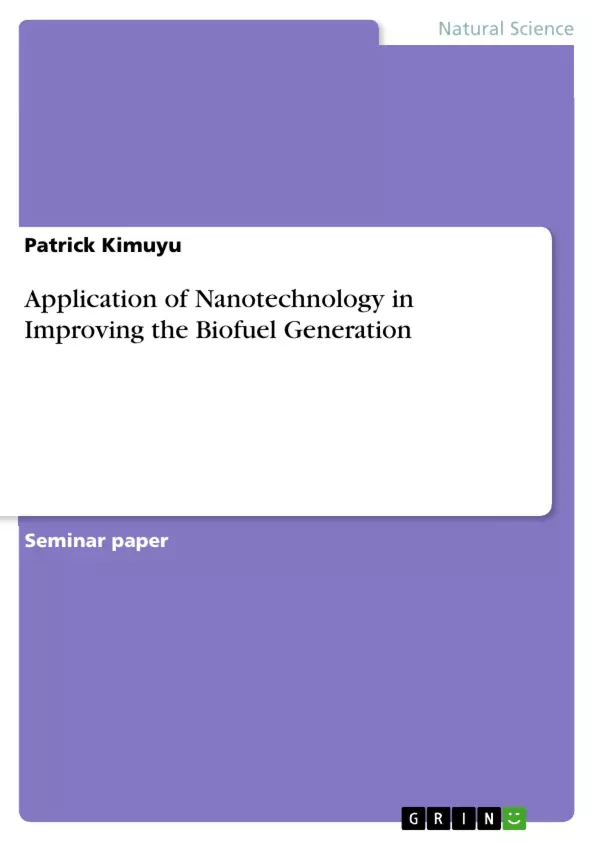For centuries, energy crisis has been a major challenge that has affected economic development in almost all nations around the globe. As a result, so as to meet the severity of this day-to-day requirement, different nations have shifted their focus towards alternative energy sources that contain diverse energetic potential, and have the ability of meeting the economic concerns among nations. Bioenergy is one of the main non-conventional resources of energy that is comprised of energy obtained from life forms (Malik, & Sangwan, 2012). High dependence on conventional sources of energy that have been directly or even indirectly obtained from fossil fuels, for example, petroleum and coal have demonstrated detrimental effects on the environment in different nations worldwide. Bioresources are eco-friendly because they are not created, are self-prevalent and everywhere, not to mention that they do not leave toxic end products after processing. Some of the major bioresources include biomass, carcasses, dead plants and cow-dung. However, there is limited biomass utilization in energetic application due to inadequate biochemical modification techniques that may facilitate profitability. Nanotechnology refers to a new dimension of material sciences that targets entities miniaturization so as to achieve improved performance through functionalities improvement. It is a dimension that is multidisciplinary in nature since it originates from diverse, overlapping natural sciences fields. It is a technology that has provided faster and reliable methods of optimizing energy generation from the bio-sources. Therefore, the main purpose of this paper is to explore the use of biomass and nanotechnology as alternative energy source.
Inhaltsverzeichnis (Table of Contents)
- Introduction
- Nanoscale Materials
- Nanobiocatalysis
- Nanotechnology for Biofuel Production from Butchery Waste
- Nanostructured Materials for Bioelectrochemical Systems
- Nanofarming Technology for Obtaining Biofuel from Algal Biomass
- Conclusion
Zielsetzung und Themenschwerpunkte (Objectives and Key Themes)
The main objective of this paper is to investigate the utilization of biomass and nanotechnology as alternative energy sources to address the ongoing global energy crisis. The text explores the potential of nanotechnology in improving bioenergy generation, focusing on the efficiency and sustainability of using biomass as a resource.
- Application of nanotechnology in bioenergy generation
- Harnessing the potential of biomass as an energy source
- Nanomaterials for biofuel production
- Nanobiocatalysis and enzyme immobilization
- Nanostructured materials for bioelectrochemical systems
Zusammenfassung der Kapitel (Chapter Summaries)
- Introduction: This chapter introduces the global energy crisis and highlights the need for alternative energy sources. The author emphasizes the importance of bioenergy, a non-conventional energy resource derived from living organisms. The paper's focus on the application of nanotechnology in improving bioenergy generation is established.
- Nanoscale Materials: This chapter delves into the definition and creation of nanoscale materials, which are fundamental to the application of nanotechnology. It discusses the two main methodologies for producing these materials: top-down and bottom-up techniques. The chapter also highlights the role of nanoparticles in enhancing microbial biotransformation, leading to increased biofuel generation.
- Nanobiocatalysis: This chapter focuses on the utilization of nanobiocatalysis for efficient and cost-effective biomass processing. It explores the challenges associated with traditional methods of oxidizing saturated hydrocarbons and introduces nanocatalysts as a solution. The chapter emphasizes the potential of nanomaterials to improve enzyme loading, recovery, and reusability, leading to more sustainable bioenergy generation.
- Nanotechnology for Biofuel Production from Butchery Waste: This chapter examines the potential of utilizing animal fats, often discarded, as a source of biofuel. It discusses the process of trans-esterification, which converts animal fats into biofuels, and highlights the role of nanoparticles in enhancing biofuel yields. The chapter emphasizes the potential of nanotechnology in transforming waste into a valuable energy resource.
- Nanostructured Materials for Bioelectrochemical Systems: This chapter explores the application of nanomaterials in microbial bioelectrochemical systems for generating electrical energy. It describes the role of nanomaterials in facilitating electric current generation in microbial fuel cells (MFCs) and microbial electrolysis cells (MECs), which are responsible for producing electricity and hydrogen, respectively. The chapter emphasizes the potential of nanomaterials in unlocking the infinite potential of bioenergy contained within microorganisms.
Schlüsselwörter (Keywords)
The primary keywords and focus topics of this text are nanotechnology, bioenergy generation, biomass, nanomaterials, biofuel production, nanobiocatalysis, enzyme immobilization, bioelectrochemical systems, microbial fuel cells (MFCs), and microbial electrolysis cells (MECs). The work explores the applications of nanotechnology in addressing the global energy crisis by efficiently utilizing biomass as an alternative energy source.
- Quote paper
- Patrick Kimuyu (Author), 2018, Application of Nanotechnology in Improving the Biofuel Generation, Munich, GRIN Verlag, https://www.hausarbeiten.de/document/423822


